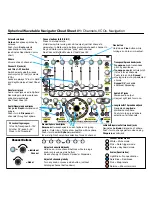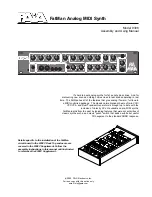
Clicking on the sequencer 256 label opens the menu, where you can launch a preset, save the current one
or create a new one (either with the current settings, or with the default values).
The Random option allows users to initialize the sequencer with random values, and trig and step
numbers.
12.4 Virtual keyboard and Controls
The illustrated red keyboard lets you send notes to the
XILS 4
, by clicking on its keys. The keyboard also
reflects the MIDI note ON information that the
XILS 4
receives, whether triggered by an external
keyboard controller, or your DAW.
When the
HOLD
button is engaged, all the notes are held until this button in disengaged.
In this panel, you will also find global controls, and an number of keyboard related parameters.
NBR VOICES:
Sets the number of available voices, in the case of polyphonic sounds.
KEYBORD MODE
: Sets the playing mode of the synthesizer. This is a drop-down menu where you can
choose between several options.
•
MONO
: Monophonic mode, only one note playing at a time, with low note priority.
•
CIRCULAR POLY
: A polyphonic mode with up to 18 active notes at a time. Each voice is chosen in a
circular manner. When a lot of voices are available, and/or long release are set up, this mode can be
very heavy on CPU use.
•
RESET POLY
: A polyphonic mode with up to 18 active notes at a time. Each new note is played with the
first free voice, cutting the current release and reducing the CPU load.
•
UNI2
: A monophonic mode with two active notes of the same pitch playing. Thanks to the
detune
knob, a phasing effect can be created.
•
UNI4
: A monophonic mode with four active notes of the same pitch playing.
•
UNI6
: A monophonic mode with six active notes of the same pitch playing.
The portamento/glide
parameters define how the note transitions behave. In monophonic mode, only one note is
played, so each transition glide occurs between two successive notes. When a polyphonic mode is enabled, note
transitions are cyclic. This means that note transitions are undetermined, and the note from which the glide is
calculated is one of the previously played notes. The following parameters are available:
PORTAMENTO:
Activates or deactivates the portamento mode. When the portamento mode is enabled, the
note transitions are progressive in pitch.
GLIDE TIME:
This knob adjusts the transition time between the notes.
GLISSENDO:
This
switch
activates semitone transitions between notes. When deactivated, the glides are
continuous.
LEGATO:
This switch
determines if the notes have to be legato to activate the glide function - i.e. if the previous
‘note off’ has to occur after the current ‘note on’.
PRIORITY
: This switch allows the selection of the mono priority mode; High or Low. In Low mode, when a
second note is pressed, it will change the pitch only if this new note is below the previous one. In High
mode,when a second note is pressed, it will change the pitch only if this new note is above the previous one.








































